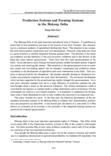Production Systems and Farming Systems in the Mekong Delta
JIRCAS international symposium series
| ISSN | 13406108 |
|---|---|
| 書誌レコードID(総合目録DB) | AA1100908X |

本文フルテキスト
intlsymp-6_177-190.pdf847.59 KB
The Mekong Delta is the most important agricultural area of Vietnam. It contributes to nearly half of food production and most of the exports of rice from Vietnam. Rice monoculture is a dominant tendency of agricultural development there. This situation is not compatible with environmental conservation and rural development. However, other than rice, there is a great potential to develop integrated farming systems there. The diversity of the physical conditions and the difference in the socio-economic conditions lead to the division of the Delta into many distinct agroecozones. There have been five main agroecosystems in the Delta: forest and barren land, floating rice-based system, rainfed rice-based system, irrigated rice system, and mixed garden system. The transition of the agroecosystems from an extensive, simple and low-yielding system into an intensive, complicated and productive system contributes to the development of agriculture and rural communities in the Delta. This transition is characterized by two dimensions: the systems naturally develop by themselves (vertically) and gradually transform into each other (horizontally). The horizontal development which has been supported by the government has rapidly changed the agroecosystems. In recent years, dramatic changes have led to a high efficiency of production systems but also have brought about a strain on the resources utilization. The vertical development which is controlled by the farmers, in contrast leads to a high performance and is in harmony with the environment but receives a very limited attention. It is important to understand the development rules of these dimensions in order to fully mobilize the resources in an integrated way.
This paper includes two parts. In the first part, the historical development of the predominant production systems in the Mekong Delta is outlined, their characteristics, performance and perspective are described. In the second part, the results of a case study in O Mon district are presented as an example of the potential of the integrated farming systems approach in the irrigated agroecosystem.
This paper includes two parts. In the first part, the historical development of the predominant production systems in the Mekong Delta is outlined, their characteristics, performance and perspective are described. In the second part, the results of a case study in O Mon district are presented as an example of the potential of the integrated farming systems approach in the irrigated agroecosystem.
| 作成者 | Dang Kim Son |
|---|---|
| 公開者 | Japan International Research Center for Agricultural Sciences |
| オンライン掲載日 | |
| 号 | 6 |
| 開始ページ | 177 |
| 終了ページ | 190 |
| 言語 | eng |
